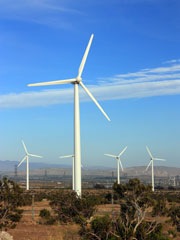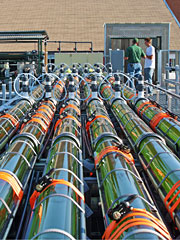
|
|
July 29, 2011
Dear Board Member,
|
| |
|
Our July research profile introduces you to Dr. Eric Williams, an industrial ecologist focused on issues of energy development and electronic waste. This interview follows a brief listing of recent ASU sustainability news and activities, below.
|
| |
|
Highlights of ASU sustainability activities
|
| |
- ASU’s Professional Science Masters in Solar Energy Engineering and Commercialization launched in 2011 to prepare future leaders in the solar energy field. The 12-month program enables students to study the technological, economic, business, and public policy aspects of solar power and also work on applied research projects in conjunction with industry and government. The growing program enrolled six students in the inaugural spring semester, nine for fall 2011, and expects to reach 30 per semester by 2016.
Read more »
|
| |
- A team of four students in ASU’s engineering and industrial design schools won second-place overall in the world’s premier student technology competition, the Microsoft Imagine Cup World Finals. ASU’s Team Note-Taker went up against more than 400 students from 70 countries with a portable device that enables visually impaired students to see a live classroom presentation and take notes at the same time. The Note-Taker device was developed in the Center for Cognitive Ubiquitous Computing in the Ira A. Fulton Schools of Engineering.
Read more » | See video »
|
| |
- ASU’s recently established Green Office program is helping sustainably minded employees engage coworkers in eco-friendly practices for their workplaces. Nine units have already completed level-one certification for the program, including the high-impact Campus Recreation department and the Office of Knowledge Enterprise Development. The program, which is offered by the Office of University Sustainability Practices, provides training and checklists of sustainable practices to educate workers and contribute to ASU’s sustainability goals.
Read more »
|
| |
- The Southwest Center for Education and the Natural Environment at ASU will boost its capacity this year to mentor science-minded high school students in ASU laboratories. The program is partnering with ASU’s LeRoy Eyring Center for Solid State Science to increase access to the Eyring Center’s world-class materials facility and faculty researchers. Students mentored by the program have won numerous state and regional science and engineering competitions in the past decade, including the prestigious Ricoh Sustainable Development Award.
Read more »
|
| |
- Seven ASU engineering undergraduates tackled the challenges of solar-powered aircraft for their senior design projects, producing a prototype that was demonstrated to a panel of prominent scientists and engineers from the U.S., Canada, and Germany. Boeing Spectrolab and Science Foundation Arizona provided support for the projects. The students will promote continued development of remote-controlled solar planes by passing their breakthroughs on to next year’s senior design teams.
Read more » | See video »
|
| |
|
Please feel free to email or call us with any questions or comments about this briefing.
Best regards,
|
| |
cc: Jim Buizer
|
| |
�
Q&A With Dr. Eric Williams
Forecasting success of new energy technologies
|
|
Eric Williams is a Senior Sustainability Scientist in the Global Institute of Sustainability and an assistant professor in both the School of Sustainability and the School of Sustainable Engineering and the Built Environment, Ira A. Fulton Schools of Engineering. He is best known for his work in life-cycle assessment, particularly the environmental impacts of recycled computer hardware. He also investigates energy topics such as the effects of development and urbanization on energy demand and forecasting technological change and growth. Dr. Williams teaches courses covering industrial ecology, design for sustainability, and sustainable consumption.
|
|
At what point did “sustainability” become part of your research vocabulary?
When I started my career as a mathematical physicist, I had never heard of the word “sustainability.” It didn’t become a part of my research focus until I made a career change, going to work for the United Nations University in Japan in their Environment and Sustainable Development Programme.
|
|
What is your most important sustainability-related research project right now?
I am working on a project that will allow us to better understand the potential for progress in emerging energy technologies such as photovoltaics, wind power, and biofuels. The world looks to these technologies to solve critical sustainability challenges, and substantial sums of public funds have been invested to improve and adopt these new energy technologies. Their development, however, is not where we need them to be in terms of their cost or impacts. More important, we still don’t understand their real potential to achieve future cost savings and also meet sustainability goals.
My project will forecast how these different technological paths can be expected to move toward their goals in coming years. It combines thermodynamic analysis of long-term efficiency limits with empirical models of historical progress. Using this technique, we can see, for example, that solar cells made from silicon wafers will require significantly increased investment to move from their current cost of $3 per watt to their target of $1 per watt.
|
|
How will your research affect policy or other decisions?
My work will provide the data that identifies which technologies are more likely to reach long-term goals. This will inform the government and private decision-makers who finance energy technology development and adoption.
|
|
What is the world sustainability challenge that concerns you most?
Energy. Nothing works without it, not even the solutions we devise for other sustainability issues. While improving technology is an important component of sustainability, it cannot be considered in isolation because as we develop more efficient technology it tends to drive greater adoption – and that creates impacts. To address this concern, we need to better understand the links between technology, growth, and adoption and then manage our systems to reduce negative effects.
|
|
|

Dr. Eric Williams
|

|

Solar panel, wind turbine, and biofuel technologies must all meet cost and efficiency goals if they are to solve critical sustainability challenges.
|
|
|






